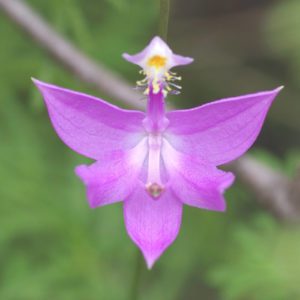Greetings, BugFans,
There’s a “chicken-or-the-egg” question about pollinators – do pollinators adapt to the flowers they visit, or do flowers adapt to their pollinators? Yes, pollinators do visit flowers that are a good fit for their various feeding apparatuses, but in an effort to extract nectar from tricky places, insects adapt and specialize https://www.youtube.com/watch?v=SZhRuo1CPq8.
Despite the popularity of wild orchids and all of the time that is spent looking at and photographing them, the pollinators for many species aren’t known. Some of our native orchids produce pollen but no nectar, and newly-emerged, “naïve bumble bees” are listed as pollinators for several of these. “Naïve” because they are attracted by scent or color to a nectar-less flower, and as they look (unsuccessfully) for a food reward, they inadvertently pick up masses of pollen. After getting the same results at a few more flowers they wise up and (no longer naïve) look for nectar elsewhere. In the meantime, some flowers get pollinated.

The “upper lip” of the Calopogon/Grass pink orchid has filaments on it that look like they might carry some pollen (a “pseudopollen lure”). When a naïve bee lands on it, the bee’s weight causes the structure to bend forward, planting the bee on its back on the pollen-producing structure. Mission accomplished – until the bee stops playing. Darwin wrote a book about the ways that orchids trick insects into visiting them.
Insect-flower relationships are a gigantic topic. Here are just a few of the intricate ways that plants and insects interact:
The BugLady mentioned recently that bumble bees can sense when a flower’s pollen has been raided by another insect. This research shows that at least one of the evening primroses can sense the bee and produce sweeter nectar when pollinators are near. If the whole article is TMI, then you can get the gist of it from the abstract. https://onlinelibrary.wiley.com/doi/10.1111/ele.13331?fbclid=IwAR23dBgR01xIOEyywLxgh0pGbXl5q59iNquJq3jhnpTYJjPzINXS17enHjk.
How do you avoid being harmed by a plant’s defensive chemicals? By being a plant, of course – or a chimera. https://www.smithsonianmag.com/smartnews-science/insect-has-plant-dna-its-genome-180977366/?utm_source=&utm_medium=&utm_campaign=&spMailingID=44717298&spUserID=ODg4Mzc3MzY0MTUyS0&spJobID=1962608328&spReportId=MTk2MjYwODMyOAS2
And a pretty unique, X-rated way that one orchid attracts beetles https://www.smithsonianmag.com/science-nature/extremely-rare-orchid-tricks-horny-beetles-carrying-its-pollen-180977332/?utm_source=smithsoniandaily&utm_medium=email&utm_campaign=20210325-daily-responsive&spMailingID=44689191&spUserID=ODg4Mzc3MzY0MTUyS0&spJobID=1962163522&spReportId=MTk2MjE2MzUyMgS2.
And finally (speaking of orchids), we all gotta eat. Pollinators make dandy prey, and smart predators hang around flowers. Here’s one of the best predators ever! https://www.sciencefriday.com/articles/unraveling-the-orchid-mantis-mystery/.
Go outside – look at insects and flowers!
Kate Redmond, The BugLady
http://uwm.edu/field-station/category/bug-of-the-week/
